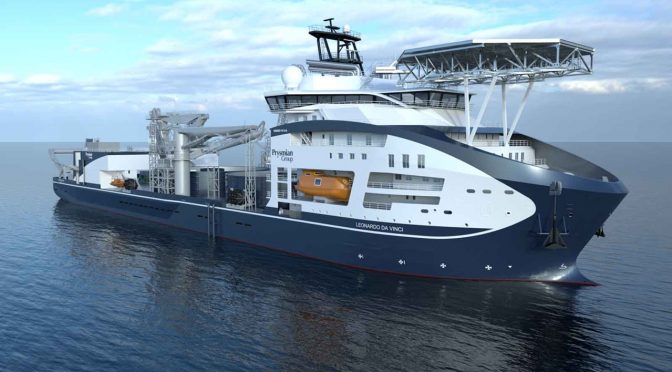Prysmian Group is set to provide a turn-key high voltage submarine and land export cable connection, including use of brand-new cable installation vessel Leonardo da Vinci, for RWE Renewable’s largest offshore wind project, 1.4 gigawatt (GW) Sofia Offshore Wind Farm sited on Dogger Bank, in the central North Sea.
A preferred bidder agreement was signed today between RWE Renewables and Prysmian Group for the design, supply, offshore route preparation, installation, commissioning and protection of the 320 kilovolt (kV) high voltage direct current (HVDC) cable system that will carry power from Sofia’s offshore converter station 227 kilometres to the project’s onshore converter station in Teesside.
The agreement includes symmetrical monopole HVDC submarine and land export cables, the latter using new eco-sustainable cable technology. It also means Sofia will be the first offshore wind project to use the 170-metre-long Leonardo da Vinci, which will be the most advanced cable-laying vessel in the world when delivered in 2021.
Sofia wind farm is 100% owned by RWE, the second biggest player in offshore wind globally and the UK’s second largest generator of electricity. By 2022, RWE plans to invest €5 billion net in the continued expansion of renewable energy, and with the UK one of their core markets in Europe.
Sven Utermöhlen, Chief Operating Officer Wind Offshore Global of RWE Renewables said : “ We are delighted to announce the selection of world leading cable supplier Prysmian as our preferred bidder for this package and confirm the project will be the first to use their latest HVDC cable technology and the cutting-edge Leonardo da Vinci . Today’s signing is another tangible step for RWE Renewables’ Sofia as the project progresses towards a final investment decision in early 2021 and is set to make a major contribution to the UK’s climate goals.”
Hakan Ozmen, EVP Projects BU, Prysmian said: “We are honoured to support RWE Renewables in this important offshore wind project, providing our state-of-the-art cable technology to support UK’s sustainable energy system towards the country’s net-zero emission target. The development of grid infrastructures for the transmission and distribution of electric power from renewable sources is strategically important, and positions Prysmian as the leading company for the energy transition.”
The contract involves more than 440 kilometres of ±320kV submarine export cables with XLPE insulation, and 15 kilometres of ±320kV land cables with P-Laser insulation, plus communications cables.
Detlev Waimann, CCO Projects BU, Prysmian Group added: “P-Laser is the first 100 percent recyclable, eco-sustainable, high-performance cable technology based on the use of a patented thermoplastic material, High Performance Thermoplastic Elastomer (HPTE) and on a zero-emission process that reduces CO2 emissions by 40 percent. This project sets an important technological milestone in the offshore wind industry, being the first ± 320kV DC offshore wind farm using P-Laser cable technology onshore.”
Onshore construction will get underway at Sofia’s converter station site in Teesside early next year, with offshore construction anticipated to start in 2023. The installation and commissioning of the HVDC export cable is due to be take place in 2024.
This HVDC export cable news follows the announcements that a consortium of GE’s Grid Solutions and Sembcorp Marine will supply Sofia’s HVDC transmission system and Siemens Gamesa Renewable Energy will supply the wind farm with its SG 14-222 DD offshore wind turbines.
For more information about Sofia visit: www.sofiawindfarm.com

